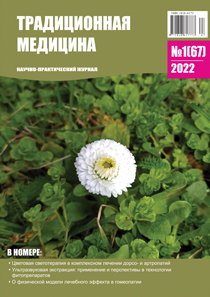Study of the East India part of the collection of medicinal raw materials of the department of pharmacognosy of St. Petersburg state chemical-pharmaceutical university
DOI:
https://doi.org/10.54296/18186173_2022_1_28Keywords:
collection of medicinal plant materials, Indian traditional medicine, SPCPUAbstract
A part of the collection of medicinal raw materials of the Department of Pharmacognosy of the St. Petersburg State Chemical and Pharmaceutical University, received from the Agricultural Museum of St. Petersburg at the beginning of the 20th century, from 309 samples of raw materials (9.2% of the total number) of plants collected in the East India, was studied. Its structure is studied by morphological groups of raw materials, producing species, genera and families. The group “Fruits” is the most widely represented (63 samples, 20.4%). Then in descending order are “Seeds” (58 samples), “Roots” (22), “Barks” (21), “Leaves” (20), “Flowers” (13), “Herbs” (12), “Rhizomes with root tubers” (4), “Galls” (4), “Sprigs” (3), “Thallus” (3), “Gums” (3), “Resins” (3), “Gum-resins” (2), “Rhizomes» (2); 10 samples represent raw materials of other groups. Plant specimens are produced from 245 species, 181 genera, 78 families. A number of species (11% of the total number) are represented by more than one group of raw materials, of which Spondias pinnata – four (fruits, bark, leaves, resin), Tamarindus indica – three (fruits, seeds, leaves). A number of genera are represented by more than one species. Four species are represented by the genera Curcuma, Ficus and Terminalia, three are the genera Piper, Sida and Vigna, two are Acacia, Asparagus, Barringtonia, Cyperus, Euphorbia, Ipomoea, Onosma, Phyllanthus, Pistacia, Rumex, Smilax, Solanum, Tamarix, Trachyspermum and Wrightia. Most of the samples (40, 12.9% of the total) are from species of the Fabaceae family, followed in descending order by Malvaceae and Poaceae (13 samples each), Moraceae (9), Asteraceae and Rubiaceae (8 each), Anacardiaceae (7), Apiaceae, Apocynaceae, Euphorbiaceae and Lamiaceae (6 each), Combretaceae, Solanaceae, Zingiberaceae (5 each), and others with fewer. The data obtained can be used to identify species that are promising for advanced study in order to create new drugs.
References
Polyakova, I.A. British Eighteenth Century Materia Medica Collections / I.A. Polyakova, C.J. Duffin, T.J. Suvorova // Collection in the space of culture: Proceedings of the International Conference. – Kaliningrad, 2019. – pp.105–125.
Paul van Duin. Collector’s Cabinet with Miniature Apothecary’s Shop / Paul van Duin. – Rijksmuseum, 2017.
C?lia Cabral e Jo?o Rui Pita. Sinopse da Hist?ria da farm?cia, Universidade de Coimbra / C?lia Cabral e Jo?o Rui Pita. – Coimbra, 2015.
Клемпер, А.В. О коллекции лекарственного растительного сырья кафедры фармакогнозии СПХФА / А.В. Клемпер, Г.А. Белодубровская, В.Г. Лужанин // III Гаммермановские чтения, СПб, 2017. С.55–58.
Klemper, A. Collection of medicinal raw materials of pharmacognosy department (poster) / A. Klemper // 22th Int. Cong. PHYTOPHARM 2018. – Vienna, 2018.
Antony Todd Tompson. A conspectus of the Pharmacopoeias of the London, Edinburgh, and Dublin (Materia medica and pharmacy) / Antony Todd Tompson. – New Jork, 1843.
Wiggers, A. Grundri? der Pharmakognosie des Pflanzenreiches / A. Wiggers. – G?ttingen, 1832.
Dunglison, R. Medical Lexicon: a new dictionary of Medical Sciences / R. Dunglison. – Philadelphia, 1839.
Martius, Theodor Wilheln Christian. Grundri? der Pharmakognosie des Pflanzenreiches / Theodor Wilheln Christian Martius. – Erlangen, 1832.
The Plant List. URL: http://www.theplantlist.org (дата обращения 15.01.2022).
MycoBank. URL: http://www.mycobank.org (дата обращения 15.01.2022).
NCBI. URL: https://www.ncbi.nlm.nih.gov (дата обращения 15.01.2022).
Downloads
Published
How to Cite
Issue
Section
License
Reproduction of any materials without the written permission of the publisher is prohibited.
The responsibility for the accuracy of the information contained in articles and advertisements are the authors and advertisers.






